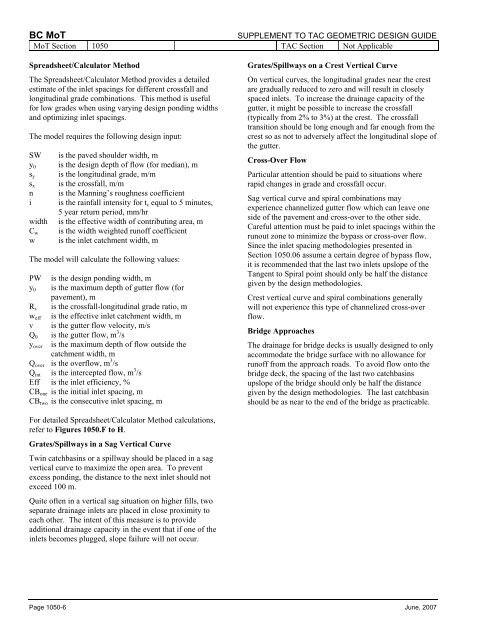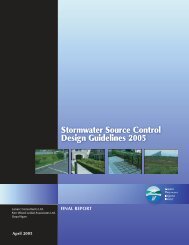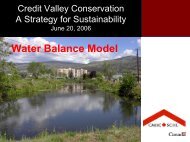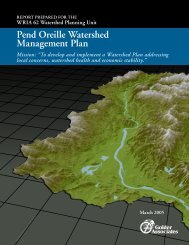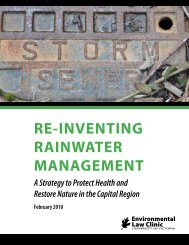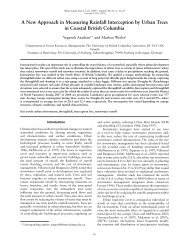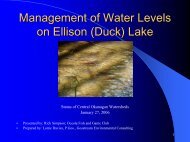1000 Hydraulics Chapter - Ministry of Transportation
1000 Hydraulics Chapter - Ministry of Transportation
1000 Hydraulics Chapter - Ministry of Transportation
Create successful ePaper yourself
Turn your PDF publications into a flip-book with our unique Google optimized e-Paper software.
BC MoT<br />
SUPPLEMENT TO TAC GEOMETRIC DESIGN GUIDE<br />
MoT Section 1050 TAC Section Not Applicable<br />
Spreadsheet/Calculator Method<br />
The Spreadsheet/Calculator Method provides a detailed<br />
estimate <strong>of</strong> the inlet spacings for different crossfall and<br />
longitudinal grade combinations. This method is useful<br />
for low grades when using varying design ponding widths<br />
and optimizing inlet spacings.<br />
The model requires the following design input:<br />
SW<br />
y 0<br />
s y<br />
s x<br />
n<br />
i<br />
width<br />
C w<br />
w<br />
is the paved shoulder width, m<br />
is the design depth <strong>of</strong> flow (for median), m<br />
is the longitudinal grade, m/m<br />
is the crossfall, m/m<br />
is the Manning’s roughness coefficient<br />
is the rainfall intensity for t c equal to 5 minutes,<br />
5 year return period, mm/hr<br />
is the effective width <strong>of</strong> contributing area, m<br />
is the width weighted run<strong>of</strong>f coefficient<br />
is the inlet catchment width, m<br />
The model will calculate the following values:<br />
PW is the design ponding width, m<br />
y 0 is the maximum depth <strong>of</strong> gutter flow (for<br />
pavement), m<br />
R s is the crossfall-longitudinal grade ratio, m<br />
w eff is the effective inlet catchment width, m<br />
v is the gutter flow velocity, m/s<br />
Q 0 is the gutter flow, m 3 /s<br />
y over is the maximum depth <strong>of</strong> flow outside the<br />
catchment width, m<br />
Q over is the overflow, m 3 /s<br />
Q int is the intercepted flow, m 3 /s<br />
Eff is the inlet efficiency, %<br />
CB one is the initial inlet spacing, m<br />
CB two is the consecutive inlet spacing, m<br />
Grates/Spillways on a Crest Vertical Curve<br />
On vertical curves, the longitudinal grades near the crest<br />
are gradually reduced to zero and will result in closely<br />
spaced inlets. To increase the drainage capacity <strong>of</strong> the<br />
gutter, it might be possible to increase the crossfall<br />
(typically from 2% to 3%) at the crest. The crossfall<br />
transition should be long enough and far enough from the<br />
crest so as not to adversely affect the longitudinal slope <strong>of</strong><br />
the gutter.<br />
Cross-Over Flow<br />
Particular attention should be paid to situations where<br />
rapid changes in grade and crossfall occur.<br />
Sag vertical curve and spiral combinations may<br />
experience channelized gutter flow which can leave one<br />
side <strong>of</strong> the pavement and cross-over to the other side.<br />
Careful attention must be paid to inlet spacings within the<br />
runout zone to minimize the bypass or cross-over flow.<br />
Since the inlet spacing methodologies presented in<br />
Section 1050.06 assume a certain degree <strong>of</strong> bypass flow,<br />
it is recommended that the last two inlets upslope <strong>of</strong> the<br />
Tangent to Spiral point should only be half the distance<br />
given by the design methodologies.<br />
Crest vertical curve and spiral combinations generally<br />
will not experience this type <strong>of</strong> channelized cross-over<br />
flow.<br />
Bridge Approaches<br />
The drainage for bridge decks is usually designed to only<br />
accommodate the bridge surface with no allowance for<br />
run<strong>of</strong>f from the approach roads. To avoid flow onto the<br />
bridge deck, the spacing <strong>of</strong> the last two catchbasins<br />
upslope <strong>of</strong> the bridge should only be half the distance<br />
given by the design methodologies. The last catchbasin<br />
should be as near to the end <strong>of</strong> the bridge as practicable.<br />
For detailed Spreadsheet/Calculator Method calculations,<br />
refer to Figures 1050.F to H.<br />
Grates/Spillways in a Sag Vertical Curve<br />
Twin catchbasins or a spillway should be placed in a sag<br />
vertical curve to maximize the open area. To prevent<br />
excess ponding, the distance to the next inlet should not<br />
exceed 100 m.<br />
Quite <strong>of</strong>ten in a vertical sag situation on higher fills, two<br />
separate drainage inlets are placed in close proximity to<br />
each other. The intent <strong>of</strong> this measure is to provide<br />
additional drainage capacity in the event that if one <strong>of</strong> the<br />
inlets becomes plugged, slope failure will not occur.<br />
Page 1050-6 June, 2007


